Type Submenu
Use this submenu to determine the type of the active image or to convert it to another type.8-bit
Converts to 8-bit grayscale. The active image must be 16-bit grayscale, 32-bit grayscale, 8-bit color or RGB color.ImageJ converts 16-bit and 32-bit images to 8-bits by linearly scaling from min-max to 0-255, where min and max are the two values displayed in the Image>Adjust>Brightness>Contrast tool. Image>Show Info displays these two values as the "Display range". Note that this scaling is not done if "Scale When Converting" is not checked in Edit>Options>Conversions. With stacks, all the slices are scaled to 8-bits using the min and max of the currently displayed slice.
RGB images are converted to grayscale using the formula gray=(red+green+blue)/3 or gray=0.299red+0.587green+0.114blue if "Weighted RGB to Grayscale Conversion" is checked in Edit>Options>Conversions.
16-bit
Converts to unsigned 16-bit grayscale. The active image must be 8-bit grayscale or 32-bit grayscale.32-bit
Converts to signed 32-bit floating-point grayscale. The active image must be 8-bit grayscale or 16-bit grayscale.8-bit Color
Converts to 8-bit indexed color using Heckbert's median-cut color quantization algorithm. A dialog box allows the number of colors (2-256) to be specified. The active image must be RGB color.RGB Color
Converts to 32-bit RGB color. The active image must be grayscale, 8-bit Color, or an RGB (red, green, blue) or HSB (hue, saturation and brightness) stack.RGB Stack
Converts to a 3-slice (red, green, blue) stack. The active image must be RGB color.HSB Stack
Converts to a 3-slice (hue, saturation and brightness) stack. The active image must be RGB color. An attempt to perform an unsupported conversion causes a dialog box to be displayed that lists the possible conversions. The * indicates that both single images and stacks can be converted.
Adjust Submenu
This submenu contains commands that adjust brightness/contrast, threshold levels and image size.Brightness/Contrast...
Use this tool to interactively alter the brightness and contrast of the active image. With 8-bit images, brightness and contrast are changed by updating the image's look-up table (LUT), so pixel values are unchanged. With 16-bit and 32-bit images, the display is updated by changing the mapping from pixel values to 8-bit display values, so pixel pixel values are also unchanged. Brightness and contrast of RGB images are changed by modifying the pixel values.Press shift-c to open the B&C window the quick and easy way. If it is already open, it is activated.
The line graph at the top of the window, which us superimposed on the image's histogram, shows how pixel values are mapped to 8-bit (0-255) display values. The two numbers under the plot are the minimum and maximum displayed pixel values. These two values define the display range, or "window". ImageJ displays images by linearly mapping pixel values in the display range to display values in the range 0-255. Pixels with a value less than the minimum are displayed as black and those with a value greater than the maximum are displayed as white.
There are four sliders. Minimum and Maximum control the lower and upper limits of the display range. Brightness increases or decreases image brightness by moving the display range. Contrast increases or decreases contrast by varying the width of the display range. The narrower the display range, the higher the contrast.
Click on Auto, and ImageJ will automatically optimize brightness and contrast based on an analysis of the image's histogram. Create a selection, and the entire image will be optimized based on an analysis of the selection. The optimization is done by allowing a small percentage of pixels in the the image to become saturated (displayed as black or white). Each additional click on Auto increases the number of saturated pixels and thus the amount of optimization.
Click on Reset to restore the original brightness and contrast settings. The display range is set to the full pixel value range of the image. A resetMinAndMax() macro call is generated if the command recorder is running.
Click on Set to enter the minimum and maximum display range values in a dialog box. A setMinAndMax() macro call is generated if the command recorder is running.
Click on Apply to apply the current display range mapping function to the pixel data. If there is a selection, only pixels within the selection are modified. This option currently only works with 8-bit images and stacks and with RGB stacks. This is the only B&C option that alters the pixel data of non-RGB images.
With DICOM images, ImageJ sets the initial display range based on the Window Center (0028,1050) and Window Width (0028,1051) tags. Click Reset and it sets the display range to the minimum and maximum pixel values. As an example, the File>Open Samples>CT image has a Window Center of 50 and Window Width of 500, so the display range is set to -200 to 300 (center-width/2 to center+width/2). Click Reset and the display range is set to -719 to 1402. Press 'h' (Analyze>Histogram) and you will see that the minimum pixel value in the image is -719 and the maximum is 1402. To display the DICOM tags, press 'i' (Image>Show Info). Press 'r' (File>Revert) to revert to the initial display range.
Threshold...
Use this tool to interactively set lower and upper threshold values, segmenting the image into features of interest and background. Pixels with brightness values greater than or equal to the lower threshold and less than or equal to the upper threshold are displayed in red. Use Analyze>Measure (with "Limit to Threshold" in Analyze>Set Measurements checked) to measure the aggregate of the selected features. Use Analyze>Analyze Particles to measure features individually. Use the wand tool to outline a single feature.Use the upper slider to adjust the minimum threshold value and the lower one to adjust the maximum. Hold the alt key down while adjusting the minimum to move a fixed-width thresholding window across the range of gray values.
The Auto button automatically sets the threshold levels based on an analysis of the histogram of the current image or selection. Apply sets thresholded pixels to black and all other pixels to white. Reset disables thresholding and update the histogram. B&W switches to a mode where features are displayed in black and background in white. Click on Set (not shown) to enter new threshold levels into a dialog box.
Size...
Scales the active image or selection to a specified width and height in pixels.Check Constrain Aspect Ratio to create an image with the specified width and have ImageJ adjust the height to maintain the original aspect ratio. Check Interpolate to use bilinear interpolation. Set New width to 0 to create an image with the specified height and have ImageJ adjust the width to maintain the original aspect ratio.
Canvas Size...
Changes the canvas size of an image or stack without scaling the actual image. The width and height may be either expanded or contracted. If the canvas size is increased, then the border is filled with the current background color. Or, if Zero Fill is checked, the border is filled with pixels that have a value of zero. Use the Image>Color>Color Picker tool to change the background color. The position of the old image within the new canvas may also be specified.
Show Info...
Opens a text window containing information about the active image. For DICOM and FITS images, also displays file header information. Use the popup menu (right-click in the Info window) to save the information to a text file or copy it to the system clipboard.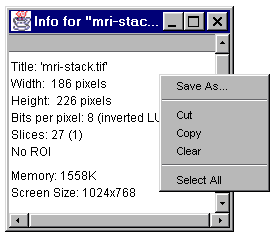
Color Submenu
Convert Stack to RGB
Converts a 2 or 3-slice stack to an RGB image. The stack must be 8-bit or 16-bit grayscale.Show LUT
Displays a plot of the active image's lookup table. The lookup table, or color table, describes the color that is displayed for each of the 256 possible pixel values. For 16 and 32 bit images, the range of displayed pixel values is mapped to 0-255. A bar under the plot displays the color representation of the pixel values. Note that RGB color images do not use a lookup table.
Color Picker...
The Color Picker tool enables the user to select foreground and background colors, which affect Edit>Fill, Edit>Draw and other color drawing commands. It displays current foreground and background colors in the selection boxes at the bottom of the window. It has two modes: foreground and background. To change modes, click on the desired selection box. Clicking on the Foreground/Background Switcher button sets the current foreground to the background and vice versa. The Black/White Reset button sets the foreground to black and the background to white.The color palette is based on HSB (Hue, Saturation and Brightness) color model. Hue increases as you go down the palette while saturation and brightness values are split horizontally. The left half of the palette varies only in brightness while the right half varies only in saturation. At the center of the color ramp are enlarged red, green, blue, cyan, magenta, and yellow colors for quick selection. To the left of the color palette is a grayscale ramp that goes from pure black to pure white.
Double-clicking on a color brings up the Color Selector, shown on the right in the illustration. Use the sliders to specify the RGB values of the foreground or background color. To get precise colors, manually change the values in the text boxes. The title of the Color Selector window ("Foreground Color" or "Background Color") indicates the current selection mode.
The Color Picker was written by Gali Baler, a 2003-2004 intern from Bethesda-Chevy Chase High School.
Stacks Submenu
This submenu contains commands that work with stacks.Add Slice
Inserts a blank slice after the currently displayed slice. Hold down the alt key to add the slice before the current slice.Delete Slice
Deletes the currently displayed slice.Next Slice
Displays the slice that follows the currently displayed slice. As a shortcut, press the ">" key.Previous Slice
Displays the slice that precedes the currently displayed slice. As a shortcut, press the "<" key.Set Slice...
Displays a specified slice. The user must enter a slice number greater than or equal to one and less than or equal to the number of slices in the stack.Convert Images to Stack
Creates a new stack consisting of all images currently displayed in separate windows. The images must all be the same type and size.Convert Stack to Images
Converts the slices in the current stack to separate image windows.Make Montage
Produces a single image which contains the images from a stack displayed in a grid format. This can be useful for visual comparisons of a series of images stored in a stack. A dialog box allows you to specify the magnification level at which the images are copied, and to select the layout of the resulting grid. With ImageJ 1.35m or later, check Use Foreground Color to draw borders and labels in the foreground color and to fill blank areas with the background color. Use the Montage Shuffler tool macro to reorder the images in the montage.Reslice...
Reconstructs one or more orthogonal slices through the image volume represented by the current stack. Before using this command, create a straight line or rectangular selection to specify were the reconstructions will be done. A dialog box allows you the specify the Z-Spacing (displacement between slices) of the source volume. Multiple slices are reconstructed and saved as a stack if you create a rectangular selection or set Slice Width greater than one.Images are created by sampling each slice in the stack along the line. Thus, the first pixel in each row of the output image is taken from the start of the line and the last from the end. In the case where Slice Width is greater than one, a stack is created by shifting the line down and to the left to generate additional slices for the output stack.
This plugin, and the ZProject plugin, were contributed by Patrick Kelly and Harvey Karten of the University of California, San Diego.
ZProject...
Projects an image stack along the axis perpendicular to image plane (the so-called "z" axis). Four different projection types are supported. Average Intensity projection outputs an image wherein each pixel stores average intensity over all images in stack at corresponding pixel location. Maximum Intensity projection creates an output image each of whose pixels contains the maximum value over all images in the stack at the particular pixel location. Sum Slices creates a real image that is is sum of the slices in the stack. Standard Deviation creates a real image containing the standard deviation of the slices.3D Project...
Generates an animation sequence by projecting through a rotating 3D data set onto a plane. Each frame in the animation sequence is the result of projecting from a different viewing angle. To visualize this, imagine a field of parallel rays passing through a volume containing one or more solid objects and striking a screen oriented normal to the directions of the rays. Each ray projects a value onto the screen, or projection plane, based on the values of points along its path. Three methods are available for calculating the projections onto this plane: nearest-point, brightest-point, and mean-value. The choice of projection method and the settings of various visualization parameters determine how both surface and interior structures will appear.This routine was written by Michael Castle and Janice Keller of the University of Michigan Mental Health Research Institute (MHRI).
Select Nearest Point projection to produce an image of the surfaces visible from the current viewing angle. At each point in the projection plane, a ray passes normal to the plane through the volume. The value of the nearest non transparent point which the ray encounters is stored in the projection image. Brightest Point projection examines points along the rays, projecting the brightest point encountered along each ray. This will display the brightest objects, such as bone in a CT (computed tomographic) study. Mean Value projection, a modification of brightest-point projection, sums the values of all transparent points along each ray and projects their mean value. It produces images with softer edges and lower contrast, but can be useful when attempting to visualize objects contained within a structure of greater brightness (e.g. a skull).
Slice Interval is the interval, in pixels, between the slices that make up the volume. ImageJ projects the volume onto the viewing plane at each Rotation Angle Increment, beginning with the volume rotated by Initial Angle and ending once the volume has been rotated by Total Rotation.
The Lower and Upper Transparency Bound parameters determine the transparency of structures in the volume. Projection calculations disregard points having values less than the lower threshold or greater than the upper threshold. Setting these thresholds permits making background points (those not belonging to any structure) invisible. By setting appropriate thresholds, you can strip away layers having reasonably uniform and unique intensity values and highlight (or make invisible) inner structures. Note that you can also use Image>Adjust>Threshold to set the transparency bounds.
Sometimes, the location of structures with respect to other structures in a volume is not clear. The Surface Opacity parameter permits the display of weighted combinations of nearest-point projection with either of the other two methods, often giving the observer the ability to view inner structures through translucent outer surfaces. To enable this feature, set Surface Opacity to a value greater than zero and select either Mean Value or Brightest Point projection.
Depth cues can contribute to the three-dimensional quality of projection images by giving perspective to projected structures. The depth-cueing parameters determine whether projected points originating near the viewer appear brighter, while points further away are dimmed linearly with distance. The trade-off for this increased realism is that data points shown in a depth-cued image no longer possess accurate densitometric values. Two kinds of depth-cueing are available: Surface Depth-Cueing and Interior Depth-Cueing. Surface Depth-Cueing works only on nearest-point projections and the nearest-point component of other projections with opacity turned on. Interior Depth-Cueing works only on brightest-point projections. For both kinds, depth-cueing is turned off when set to zero (i.e. 100% of intensity in back to 100% of intensity in front) and is on when set at 0<n 100 (i.e. (100-n)% of intensity in back to 100% intensity in front). Having independent depth-cueing for surface (nearest-point) and interior (brightest-point) allows for more visualization possibilities.
Check Interpolate to generate a temporary z-scaled stack that is used to generate the projections. Z-scaling eliminates the gaps seen in projections of volumes with slice spacing greater than 1.0 pixels. This option is equivalent to using the Scale plugin from the TransformJ package to scale the stack in the z-dimension by the slice spacing (in pixels). This checkbox is ignored if the slice spacing is less than or equal to 1.0 pixels.
Plot Z-axis Profile
Plots the ROI selection mean gray value versus slice number. Requires a selection.Start Animation
Animates the active stack by repeatedly displaying its slices (frames) in sequence. Use Stop Animation, or click with the mouse, to stop. Open the Animation Options dialog box to specify the animation speed. More than one stack can be animated at a time. As a shortcut, press the backslash key ("\") to start or stop animation. In ImageJ 1.38 and later, press alt plus backslash to open the Animation Options dialog.Stop Animation
Terminates animation of the active stack. As a shortcut, press the backslash key.Animation Options...
Use this dialog to set the animation speed in frames per second, set the starting and ending frame (1.38 or later), or to enable "oscillating" animation. In ImageJ 1.38 or later, you can press alt plus backslash to display this dialog.
Crop
Crops the image or stack based on the current rectangular selection. With ImageJ 1.38 or later, you can crop by pressing shift-x.Duplicate
Creates a new window containing a copy of the active image or rectangular selection. Hold the alt key down to skip the dialog box.Scale...
Resizes the image or selection horizontally and/or vertically by scale factors entered into a dialog box. Check Interpolate to scale using bilinear interpolation. Use integer scale factors (2, 3, 5, etc.) for the best looking results, particularly with graphics and text. With scale factors less then 1.0, smoothing the source image prior to scaling may produce better looking results.
Rotate Submenu
This submenu contains commands that rotate the active image or stack.Flip Vertical
Turns the image or selection upside down.Flip Horizontal
Replaces the image or selection with a mirror image of the original.Rotate 90 Degrees Right
Rotates the entire image or stack clockwise 90 degrees.Rotate 90 Degrees Left
Rotates the entire image or stack counter-clockwise 90 degrees.Arbitrarily...
Use this dialog to rotate the active image or selection clockwise the specified number of degrees. Set Grid Lines to a value greater than zero to superimpose a grid on the image in preview mode. Check Interpolate to use bilinear interpolation. With 8-bit and RGB images, check Fill with Background Color to fill with the backgound color instead of zero. Double click on the eye dropper tool to set or view the background color. Check Enlarge to Fit Result and the image will be enlarged as needed to avoid clipping.
Zoom Submenu
This submenu contains commands that control how the current image is displayed. The "+" and "-" keys are the preferred way to use the In and Out commands.In
Zooms in to next higher magnification level and, if possible, enlarges the window. Use the "+" key as a shortcut. Hold down the shift key to prevent the window from being enlarged. Hold down the space bar and drag to scroll the zoomed image. Double-click on the magnifying glass tool to revert to the magnification used when the image was first opened. There are 21 possible levels (shown in title bar): 3.1, 4.2, 6.3, 8.3, 12.5, 16.7, 25, 33.3, 50, 75, 100, 150, 200, 300, 400, 600, 800, 1200, 1600, 2400 and 3200 percent.Out
Zooms out to next lower magnification level and, if needed, shrinks the window. Use the "-" key as a shortcut.View 100%
Displays the image using 100% magnification (1 image pixel = 1 screen pixel). Enable "Open Images at 100%" in the Edit>Options>Appearance dialog to have images automatically opened at 100% magnification.Original Scale
Displays the image at the magnification used when the image was first opened. As a shortcut, double click on the magnifying glass tool.To Selection
Zooms in based on the current selection.
Lookup Tables
This submenu contains a selection of color lookup tables that can be applied to grayscale images to produce false-color images. If no image is open, a 256x32 ramp image is created to display the color table. More than 100 additional lookup tables are available at rsb.info.nih.gov/ij/download/luts/. They are also available as a ZIP archive at rsb.info.nih.gov/ij/download/luts/luts.zipInvert LUT
Inverts the current lookup table. For 8-bit images, the value (v) of each entry in the table is replaced by 255-v. With inverted LUTs, pixels with a value of zero are white and pixels with a value 255 are black. Unlike the Edit>Invert command, pixels values are not altered, only the way the image is displayed on the screen.Apply LUT
Applies the current lookup table function to each pixel in the image or selection and restores the default identity function. This modifies the gray values so that when the image is viewed using the default grayscale lookup table it will look the same as it did before. This command is equivalent to clicking on "Apply" in Image>Adjust>Brightness/Contrast. For thresholded images, it is equivalent to clicking on "Apply" in Image>Adjust>Threshold.
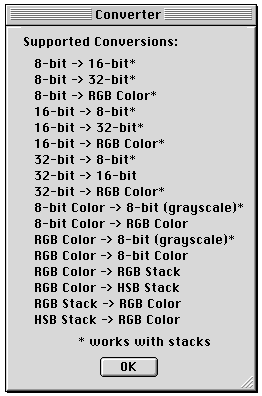
![[B&C]](../images/adjuster.jpg)
![[Min Max Dialog]](../images/set-min-max.jpg)
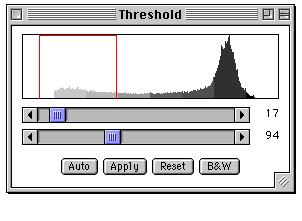
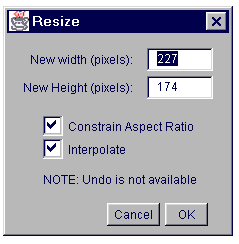
![[Canvas Size]](../images/canvas-size.jpg)
![[LUT]](../images/lut.gif)
![[Color Picker]](../images/picker.jpg)
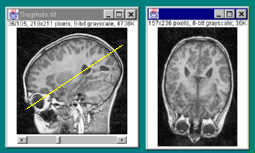
![[Dialog]](../images/project.jpg)
![[Dialog]](../images/animation-options.gif)
![[dialog]](../images/rotate.jpg)